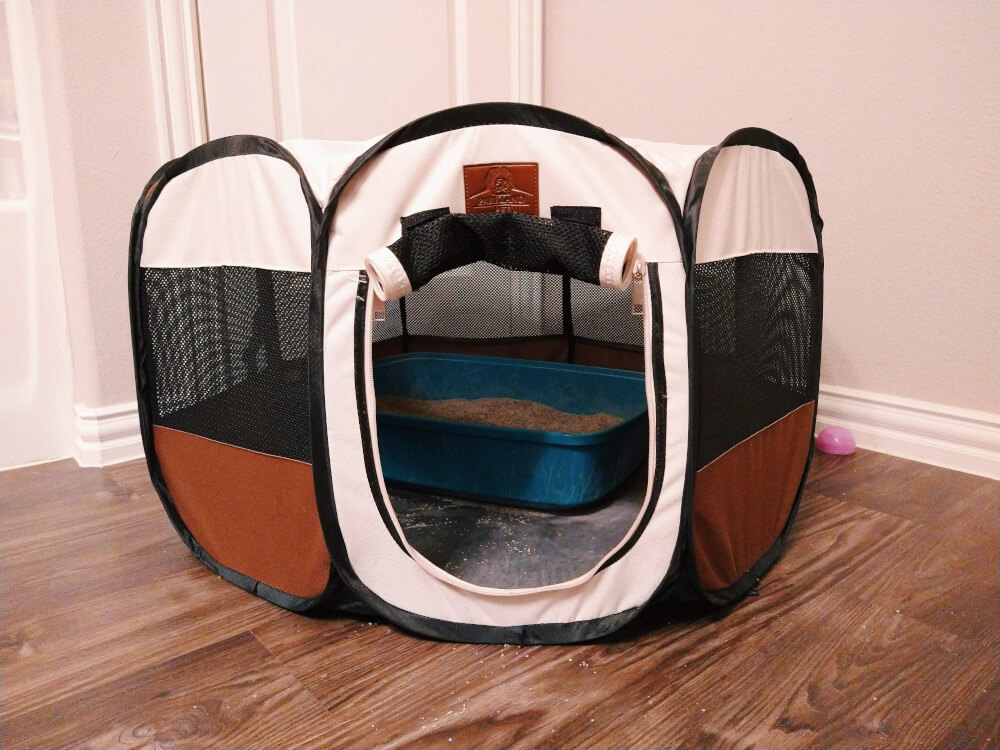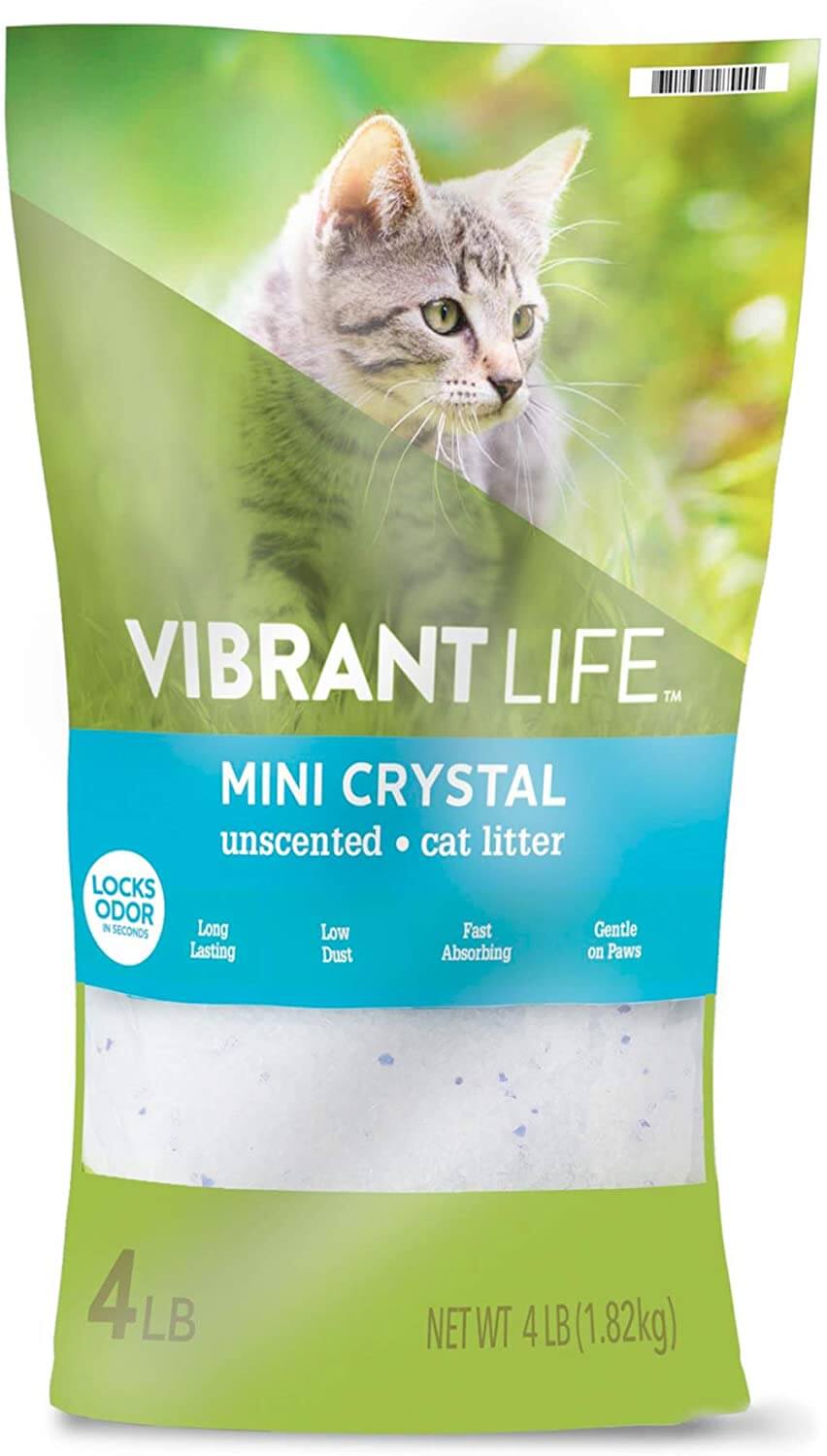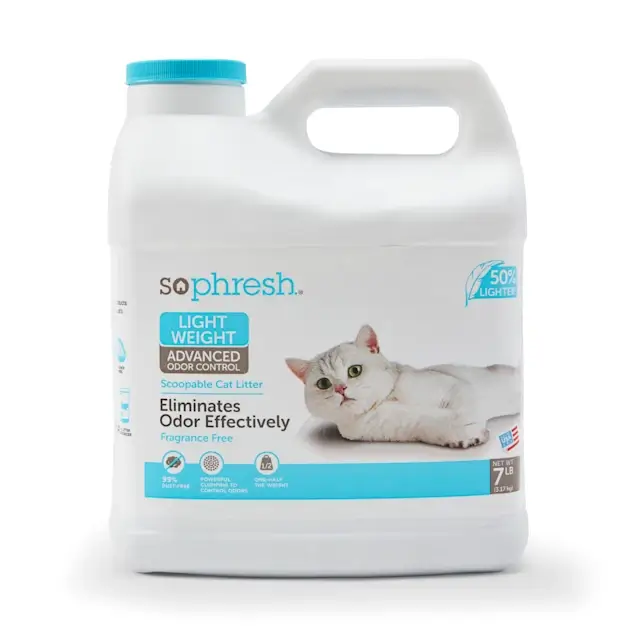Choosing the best cat litter for your family is about more than what your cat likes and is good for the environment. When you or another human in your home has allergies, eco-friendly cat litter may not work for your cat. Some eco-friendly cat litter may even aggravate your fur baby’s allergies!
I navigated this minefield, so you won’t have to. Unless you’re in it right now — yikes on bikes, but at least now we can trauma bond?
Everyone has lists on lists of the best cat litter for their cats, but I have yet to see anyone mention their own allergies into the equation.

Shopping for cat consumables — like cat litter, cat food, cat shampoo — hits differently when you have allergies. When my her vet prescribed a shampoo for potential ringworm, my first thought was, “This isn’t gonna have eucalyptus or nuts in it, right?” I’m not about to have to decide between curing my cat’s skin infection and using my epinephrine, am I?!
Types of cat litter
Before you can choose the best cat litter for your household, knowing the different types of cat litter that exist can help you determine which cat litter will be best to start with.
Clay litter 🏺
The default cat litter is clay litter. When your cat relieves herself and kicks kitty litter to cover the result, clay litter will clump around anything with moisture, and form what looks like — and feels a bit like when you’re scooping — rock clumps.
The cheapest of store-bought cat litter is going to be clay litter, which you can often find at dollar-twenty-five-cent stores for $1.25 these days.
Clay litter is the least-environmentally-friendly cat litter out there due to the bentonite clay base obtained from strip mining and lack of biodegradability.
Many clay litters will also create dust when you’re sifting or refilling, or your cat is rummaging around in their poop palace.
However, bentonite clay is used in many beauty products and hundreds of homeopathic remedies — I put this shit on everything — so it’s actually the type of litter that works best for my cat and me, compared to the other options. I think I’m one of the only pet bloggers who isn’t telling you not to use clumping litter or else — and that’s because, as you’ll learn below, the alternatives literally cannot work for both my cat and myself.
The only thing I strongly dislike about clumping litter is that bits will sometimes get in between Galaxy’s toe beans, and she hates it when I have to get her paw wet to dislodge it. I’ve almost taken her to the vet over it a few times. This happens despite keeping her two litter boxes clean!
A small thing I dislike about clumping litter is that I cannot easily monitor whether my cat with gastrointestinal issues has diarrhea.
Corn litter 🌽
Corn litter is often low-key scented. It’s lightweight and has minimal clumping capabilities.
Concerns cat parents have mentioned in regard to corn litter include mold growth, namely aflatoxins. Corn can easily produce aflatoxins, which can be deadly to pets. I am allergic to molds, so litter with potential to develop mold is a hard pass.
Grass cat litter 🍀
Grass-based cat litter is made with grass seeds and is compostable, biodegradable, and clumps. It’s considered low-dust.
Grass seed pollen caused grass allergies, which I have loads of — so this litter was never an option for me, even though it’s super eco-friendly and would wholeheartedly have been my first choice!
Paper cat litter 📰
Paper cat litter is sold as processed, recycled paper material or pellets. I’ve seen posts by cat parents who use their shredded paper supply for cat litter for their cats with injured paws or because of previous litter-related injuries and illnesses, since paper is softer and can’t irritate wounds.
Paper litter doesn’t clump, however, and the non-pellets may not be great for cats who prefer to cover their bathroom business.
This was a last resort option for me, but I haven’t tried it.
Silica gel litter 💎
Silica gel litter, commonly known as crystal cat litter, companies claim this type of litter to be less dusty and more of a money-saver because you use less of it. The crystals absorb liquid from urine and moisture from poop, so you only have to scoop out solids. However, if your cat isn’t producing solid feces, it will be more difficult to scoop up and you’ll wind up with bits of poop in random areas of the litter box.
Stepping on crystal cat litter, which is much smaller than LEGO blocks, hurts about the same as stepping on LEGOs because you never step on just one. Crystal-based cat litter companies also claim their silica-based litter doesn’t track outside the litter box, but…it does. It really does. It really hurts, too.
I used crystal cat litter for a month and a half before switching to a clumping litter per Galaxy’s vet tech’s recommendation, and I’m never going back. In our experience, crystal cat litter was dusty, too. Galaxy coughed every time she used the litter box, and triple-sneezed at one point.
Silica-based cat litter is also not eco-friendly for the same reasons as clumping litter (minus the clay base), but this was not the reason I chose it.
Walnut shell litter 🥜
Walnut shell litter is made from ground walnut shells. Compared to clay litter, walnut shell litter biodegrades, absorbs more, tracks less, and clumps and controls odors better. If you’re only allergic to dust, walnut shell litter supposedly has much less. Depending on your cat’s kitty karate skills and the company, slight red or brown dust may occur.
This was never an option due to my life-threatening nut allergies.
Wheat-based cat litter 🌾
Wheat-based cat litter is biodegradable and compostable, and it clumps! Urine turns the wheat pellets into a sawdust-like form, which should then be scooped out. Odor control is also promised.
This was never an option for me because I know a lot of people are gluten intolerant or allergic to wheat, and I do not want that constantly infusing everything in my home.
Wood-based cat litter 🪵
Wood based litter is made from a variety of woods — like pine, cedar and oak. Odor control is natural.
Wood-based cat litter has been kiln-dried and formed into non-clumping pellets that resemble hamster food, or is sold as clumping sawdust that your neighborhood lesbian could probably make. It might be one of the most environmentally-friendly cat litters because it’s ecologically sustainable to manufacture, and biodegradable and compostable to dispose of.
We’ve never tried this cat litter, because it was never — and never will be — an option for us. I’m highly allergic to pine and cedar, and I don’t want to take my chances with oak litter. Cat litter is not FDA-regulated, so companies are not held to high standards when creating their kitty litter. All it takes is one slip up — one moment of, oh, let’s just throw in some pine; it’ll be fine! for me to have a life-threatening allergic reaction.
Not worth it.
What cat litter do cats prefer?
Many humans don’t realize that, whilst cats basically domesticated themselves, they are definitely not dogs. Cats still have a lot of their ancestral instincts, so imposing what is more convenient for you onto your cat despite their instincts is not the healthiest option.
Teaching your cat to potty in the toilet may be a great conversation starter and help you out, but that unnatural behavior comes with too many risks.
Cats prefer to cover their existence.
When I used crystal cat litter, my cats would spend more time rummaging around their litter box. Most of the time, they wouldn’t use it — they’d just step in to recover the poo or because they would smell their urine. Urine turns crystal litter yellow, so it doesn’t stay crystal clear for more than a week.
In the wild, cats would cover their bathroom biz with dirt. The cat litter most resembling this effect is going to be clay litter that clumps.
Cats may prefer unscented grounds.
Cats are territorial. The reason the litter box recommendation for two or more cats is the number of cats you have, plus one, is because territorial issues may arise.
Scented cat litter may also mess with their allergies or be too much sensory input for them. Some cats may like scented litter, but in my experience (I’ve had 20+ cats in my lifetime), the scented litter did not win.
Scented litter may also increase human allergies, as cat litter allergies are very much a thing. It’s like walking down the laundry detergent or candle aisle, or past someone wearing a lot of perfume.
Cat preferences differ.
Ultimately, every cat is different. Even though you like and prefer one litter because it meets your needs and environmental standards, your cat may wind up preferring the medium-to-light clumping clay litter that smells like absolutely nothing.
The best solution is to leave the final decision up to your cat, because forcing your cat to use the cat litter you prefer is breeding grounds for litter box-related behavioral issues, which create tension between you and your cat.
Cat litters we’ve tried
I’ve only tried three different cat litters, but my cat litter journey may help you figure out the best cat litter option for you and your cat(s)!
Vibrant Life Mini Crystal Unscented Cat Litter

At the time I used Vibrant Life’s Mini Crystal Unscented litter, I also had Galaxy’s brother, Leo. The vet suspected they had a lot of worms due to their big, round bellies, and Leo peed a lot. It smelled a lot. Even though the package said the litter only needed to be dumped entirely each month, I had to dump it every one to two weeks to keep the smell down. Having two sweet-smelling kittens was nothing against the litter box.
Ultimately, Galaxy’s coughing with every litter box usage was officially a health concern for her. For me, it was stepping on the crystals Galaxy tracked across my apartment’s hardwood flooring with my soft feet and discovering crystal cat litter is sharp enough to cut human skin on impact.
So Phresh Lightweight Litter

Galaxy’s vet tech recommended So Phresh litter, also known as Petco’s cat litter brand, because it was what she used. I decided to test out a small bag of the litter and chose lightweight, because it was lighter to carry.
I put So Phresh Lightweight Litter into Galaxy’s bathroom litter box, and she took to it immediately. She didn’t return to her crystal litter at all.
It is a clumping, clay-based litter. It does track, but it’s not as bad and definitely remains in the bathroom/litter box area. Minimal dust.
The only downside is that you can’t refill the lightweight litter in-store, because it’s only the regular So Phresh, which is outrageously heavy.
So Phresh Litter
I bought the basic, everyday So Phresh Litter you can refill in the store. It’s obnoxiously heavy, and I wish it wasn’t with every fiber of my being — but it is what it is. I think Galaxy also prefers the lightweight version, but she will use this litter.
The regular So Phresh litter contains slightly more dust when adding to the litter box or dumping to start anew, but the pros outweigh that.
The only downside is that it’s heavy.
How to switch to a different cat litter
To avoid stressing out your cat, don’t stop using the old kitty litter abruptly. The only family member who willingly embraces change is a baby with a dirty diaper (and that’s saying a lot, because they’ll still fight you while 💩 is leaking up their backside).
There are two ways to introduce your cat to different/new cat litter:
- Fill one litter box with new litter, while the other contains the old litter.
- Pour or mix 50% new litter on top of old cat litter.
Keep both litter boxes clean. A common recommendation on social media and internet forums is to let the litter box with the previous cat litter to get dirty, but not cleaning out your litter box — even just one — can result in negative litter box behaviors that build tension between you and your cat.
Cats can smell the slightest of body chemistry changes within you, so they can sense your stress and will react to it accordingly. Litter box behavioral issues can also mask more serious health problems, so seek to avoid negative consequences as much as you can.
For example, if your cat is allergic to the new kitty litter or is struggling to make it to the litter box in time due to gastrointestinal issues, keeping the old litter box dirty is going to result in her finding another place to potty.
You wouldn’t like being forced to 💩 elsewhere with an upset stomach, so don’t force that on your cat.
Love this post?
Support me by subscribing to my blog and/or buying me a cuppa:
Comments on this post
Yvonne
Thank you for writing this article and sharing your personal experiences with choosing the best cat litter for your family. It’s great to see that you not only considered your cat’s preferences, but also your own allergies when making this decision. Your mention of the different types of cat litter and their pros and cons was very helpful, and I appreciate that you included your own experiences with trying out different litters. It’s important to consider all of these factors when choosing the best cat litter for our households.
Leave a comment